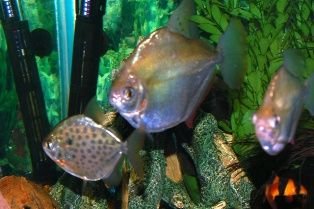Common name: Silver dollar
Scientific name: Metynnis argenteus
Family:Serrasalmidae
Origin: Amazon basin
Maximum size: 5"
Care: Silver dollars are a schooling fish and should be kept in groups of 5 or more, for this reason a tank of at least 55 gallons is recomended. They are herbivors that will make short work of most aquarium plants, hardy plants like Java fern and Anubias may be left alone. The fish preffers soft slightly acidic water but can be kept in water with a pH of up to 7.5 and a hardness of 20 GH without problems, the temperature should be kept between 24 and 28 celcius (75-82f). The fish can be extremely shy and nervous if placed in a tank with overly aggressive fish or the tank is placed in a high traffic area.
Feeding The fish should be fed mainly vegetable foods such as lettuce, spinach, courgette (zuchini) and watercress though small live and frozen foods such as bloodworms and daphnia will also be taken.
Sexing: The male has a longer anal fin with a reddish tinge to the front.
Breeding: Breeding is rare but possible, the key is very soft acidic water (pH 6, GH 10, KH -4). The fish are egg scatterers.
Scientific name: Metynnis argenteus
Family:Serrasalmidae
Origin: Amazon basin
Maximum size: 5"
Care: Silver dollars are a schooling fish and should be kept in groups of 5 or more, for this reason a tank of at least 55 gallons is recomended. They are herbivors that will make short work of most aquarium plants, hardy plants like Java fern and Anubias may be left alone. The fish preffers soft slightly acidic water but can be kept in water with a pH of up to 7.5 and a hardness of 20 GH without problems, the temperature should be kept between 24 and 28 celcius (75-82f). The fish can be extremely shy and nervous if placed in a tank with overly aggressive fish or the tank is placed in a high traffic area.
Feeding The fish should be fed mainly vegetable foods such as lettuce, spinach, courgette (zuchini) and watercress though small live and frozen foods such as bloodworms and daphnia will also be taken.
Sexing: The male has a longer anal fin with a reddish tinge to the front.
Breeding: Breeding is rare but possible, the key is very soft acidic water (pH 6, GH 10, KH -4). The fish are egg scatterers.



